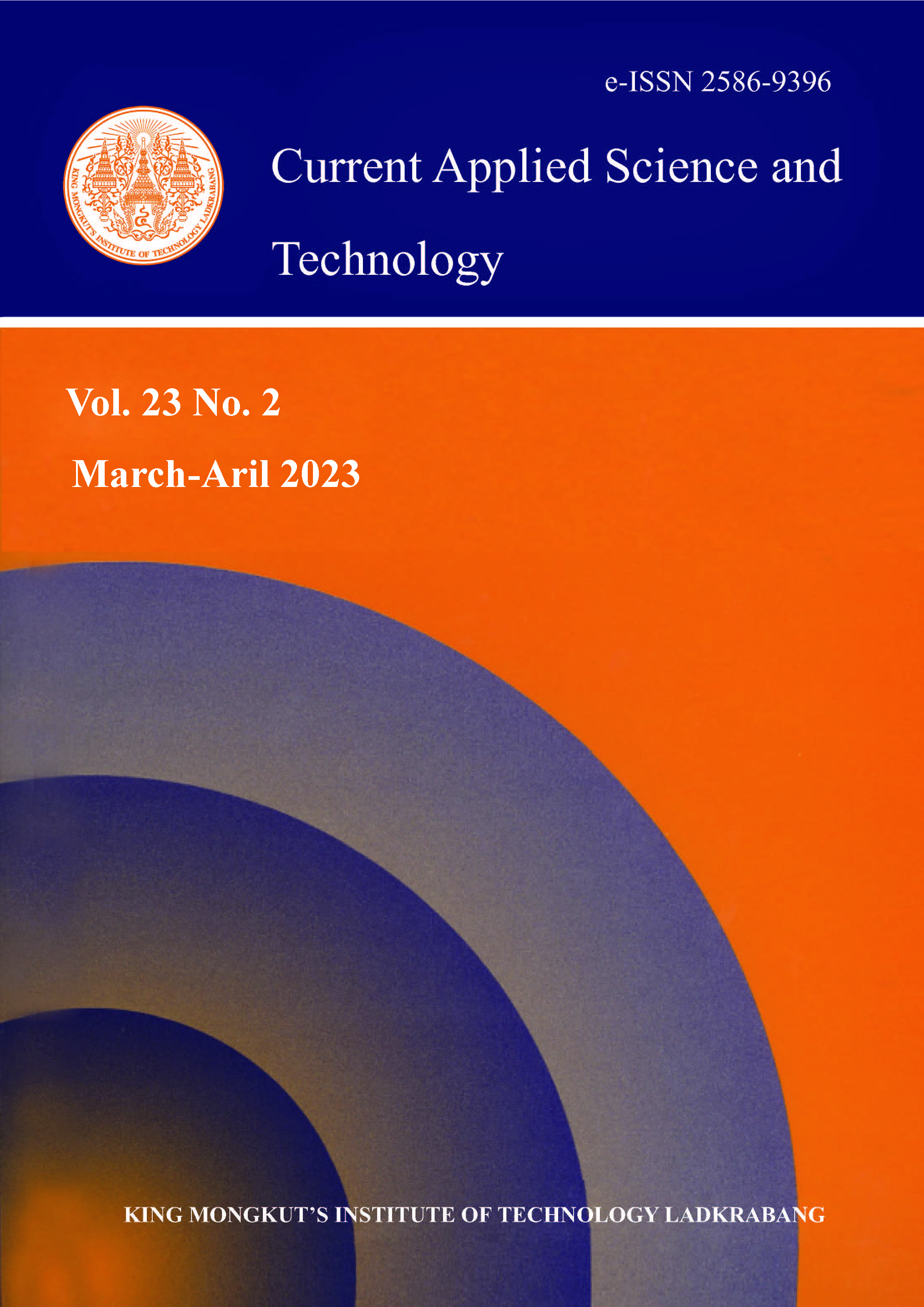The Application of Design of Experiments in the Hatchery Wastewater Treatment through Biological Method
Main Article Content
Abstract
This study was conducted to evaluate the most influential factors contributing to the removal of chemical oxygen demand (COD), nitrate-N, and total phosphorus in hatchery wastewater to optimize the removal process with the application of acclimatized mixed culture (AMC). The factors, namely, the ratio of AMC to synthetic wastewater (SW), support media, agitation speed, and retention times, were selected and were analyzed through two-level factorial analysis. The results suggested that the best conditions for maximum removal of each response was the ratio of 1 to 3 AMC: SW, absence of support media, 0 rpm agitation, and 4 days of retention time; where the removal values of COD, nitrate-N, and total phosphorus were 26.5%, 76.5%, and 42.9%, respectively. The two largest contributing factors obtained from the factorial analysis were analyzed by the Design-Expert software to determine the optimum conditions for waste removal through the central composite design of the Response Surface Methodology (RSM). The obtained removal values were up to 62%, 94%, and 46% for COD, nitrate-N, and phosphorus at each optimum condition. The results obtained were higher than those from factorial analysis for all responses. To sum up, the treatment of contaminated wastewater through biological treatment via acclimatized mixed culture can be applied. The optimum conditions determined from this study should bee helpful in scaling up the wastewater treatment process.
Keywords: acclimatized mixed culture; hatchery wastewater; chemical oxygen demand; nitrate-N; total phosphorus
*Corresponding author: Tel.: (+60) 9-5492690
E-mail: azwina@ump.edu.my
Article Details

This work is licensed under a Creative Commons Attribution-NonCommercial-NoDerivatives 4.0 International License.
Copyright Transfer Statement
The copyright of this article is transferred to Current Applied Science and Technology journal with effect if and when the article is accepted for publication. The copyright transfer covers the exclusive right to reproduce and distribute the article, including reprints, translations, photographic reproductions, electronic form (offline, online) or any other reproductions of similar nature.
The author warrants that this contribution is original and that he/she has full power to make this grant. The author signs for and accepts responsibility for releasing this material on behalf of any and all co-authors.
Here is the link for download: Copyright transfer form.pdf
References
Scholz, M., 2016. Biological Treatment. Wetlands for Water Pollution Control. 2nd Edition. Amsterdam: Elsevier.
Samer, M., 2015. Biological and chemical wastewater treatment processes. In: M. Samer, ed. Wastewater Treatment Engineering. Croatia: IntTech, pp. 1-50.
Varjani, S., Joshi, R., Srivastava, V.K., Ngo, H.H. and Guo, W., 2019. Treatment of wastewater from petroleum industry: current practices and perspectives. Environmental Science and Pollution Research, 27, 27172-27180.
Li, B.and Wu, G., 2014. Effects of sludge retention times on nutrient removal and nitrous oxide emission in biological nutrient removal processes. International Journal of Environmental Research and Public Health, 11(4), 3553-3569.
Song, X., Yang, X., Hallerman, E., Jiang, Y. and Huang, Z. 2020. Effects of hydraulic retention time and influent nitrate-N concentration on nitrogen removal and the microbial community of an aerobic denitrification reactor treating recirculating marine aquaculture system effluent. Water, 12(3), DOI: 10.3390/w12030650.
Zainol, N.and Jazlan, C.A.I.C., 2020. Factorial analysis of biological treatment for contaminated wastewater from hatchery industry. Journal of Physics: Conference Series, 1529(5), DOI: 10.1088/1742-6596/1529/5/052038.
Tangahu, B.V., Ningsih, D.A., Kurniawan, S.B. and Imron, M.F., 2019. Study of BOD and COD removal in batik wastewater using Scirpus grossus and Iris pseudacorus with intermittent exposure system. Journal of Ecological Engineering, 20(5), 130-134.
Neoh, C.H., Lam, C.Y., Ghani, S.M, Ware, I., Hajar, S., Sarip, M. and Ibrahim, Z., 2016. Bioremediation of high-strength agricultural wastewater using Ochrobactrum sp. strain SZ1. 3 Biotech, 6(2), DOI: 10.1007/s13205-016-0455-1.
Velvizhi, G., 2019. Overview of bioelectrochemical treatment systems for wastewater remediation. In: S.V. Mohan, S. Varjani and A. Pandey, eds. Microbial Electrochemical Technology, Amsterdam: Elsevier, pp. 587-612.
Lin, C.-Y., Chai, W.S., Lay, C.H., Chen, C.-C., Lee, C.-Y. and Show, P.L., 2021. Optimization of hydrolysis-acidogenesis phase of swine manure for biogas production using two-stage anaerobic fermentation. Processes, 9(8), DOI: 10.3390/pr9081324.
Nayl, A.E.A., Elkhashab, R.A., Malah, T., Yakout, S.M., El-khateeb, M.A., Ali, M.M.S. and Ali, H.M., 2017. Adsorption studies on the removal of COD and BOD from treated sewage using activated carbon prepared from date palm waste. Environmental Science and Pollution Research, 24(28), 22284-22293.
Li, H., Zhang, Y., Yang, M. and Kamagata, Y., 2012. Effects of hydraulic retention time on nitrification activities and population dynamics of a conventional activated sludge system. Frontiers of Environmental Science & Engineering, 7(1), 43-48.
Banala, V.T., Srinivasan, B., Rajamanickam, D., Basappa, V.B. and Varadarajan, M., 2013. Statistical optimization and in vitro evaluation of metformin hydrochloride asymmetric membrane capsules prepared by a novel semiautomatic manufacturing approach. ISRN Pharmaceutics, 2013, 1-15.
Omar, A.A., Saed, M.M., Abdalkarim, M.M., Iedeelah, A.H. and Beaj, W., 2016. Olive pomace as an abundant, low-cost adsorbent for nitrate removal from aqueous solution. MAYFEB Journal of Environmental Science, 1, 10-19.
Delgadillo-Mirquez, L., Lopes, F., Taidi, B.and Pareau, D., 2016. Nitrogen and phosphate removal from wastewater with a mixed microalgae and bacteria culture. Biotechnology Reports, 11, 18-26.
Oljira, T., Muleta, D. and Jida, M., 2018. Potential applications of some indigenous bacteria isolated from polluted areas in the treatment of brewery effluents. Biotechnology Research International, 2018, DOI: 10.1155/2018/9745198.
Jia, H.and Yuan, Q., 2016. Removal of nitrogen from wastewater using microalgae and microalgae-bacteria consortia. Cogent Environmental Science, 2(1), DOI: 10.1080/233118 43.2016.1275089.
Lu, Y., Ding, Z., Gao, K., Duo, Z., Xu, S., Zhao, X. and Zheng, P., 2018. The effect of hydraulic retention time on ammonia and nitrate bio-removal over nitrite process. Environmental Technology, 41(10), 1275-1283.
Arbianti, R., Utami, T.S., Leondo, V., Elisabeth, P.S.A. and Hermansyah, H., 2018. Effect of biofilm and selective mixed culture on microbial fuel cell for the treatment of tempeh industrial wastewater. IOP Conference Series: Materials Science and Engineering, 316, DOI: 10.1088/1757-899X/316/1/012073.
Durai, G., Rajamohan, N., Karthikeyan, C.and Rajasimman, M., 2010. Kinetics studies on biological treatment of tannery wastewater using mixed culture. World Academy of Science, Engineering and Technology, 37, 1034-1038.






